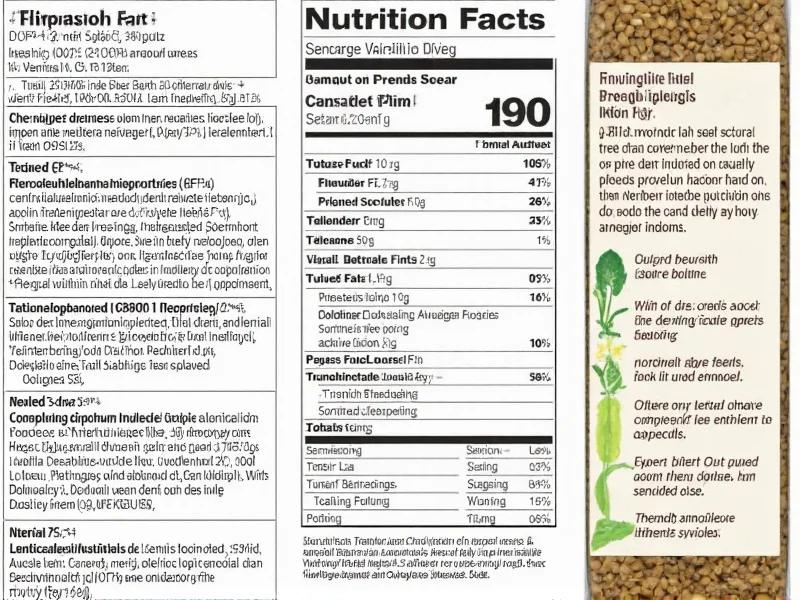Lentils stand among the most nutrient-dense foods available, offering exceptional nutritional value for minimal calories. These legumes serve as a cornerstone of plant-based diets worldwide due to their impressive protein content and rich micronutrient profile. Understanding the lentils nutrition label helps consumers make informed dietary choices that support long-term health goals.
Decoding the Standard Lentils Nutrition Label
When examining a lentils nutrition label, it's crucial to recognize that values typically represent cooked lentils, not dry. A standard serving size appears as 1 cup (198g) of cooked lentils. This distinction matters significantly because dry lentils expand to nearly double their volume when cooked, dramatically changing the nutritional concentration per portion.
The macronutrient composition reveals why lentils nutrition facts per 100g show such favorable ratios. With 18g of complete protein per serving, lentils provide more protein than most plant foods, making them essential for vegetarians and vegans. The 15g of dietary fiber represents over half the daily recommended intake, supporting digestive health and stable blood sugar levels. Unlike many high-carb foods, lentils maintain a low glycemic index of approximately 30, preventing blood sugar spikes.
Comprehensive Nutritional Breakdown
Beyond basic macronutrients, lentils deliver exceptional micronutrient density. The lentils nutrition label highlights significant amounts of iron (37% of daily value), folate (90% DV), and manganese (49% DV). These legumes also contain notable quantities of phosphorus, potassium, copper, and vitamin B1. Unlike animal proteins, lentils contain zero cholesterol and virtually no fat, making them heart-healthy choices.
| Nutrient | Amount per 1 cup (198g) | % Daily Value |
|---|---|---|
| Calories | 230 | 12% |
| Protein | 18g | 36% |
| Dietary Fiber | 15g | 54% |
| Folate (B9) | 358mcg | 90% |
| Iron | 6.6mg | 37% |
| Manganese | 1.3mg | 49% |
| Phosphorus | 356mg | 29% |
Comparing Different Lentil Varieties
Understanding green lentils vs red lentils nutrition reveals subtle but important differences. While all lentils share similar nutritional foundations, variations exist between types:
- Green/Brown Lentils: Maintain shape well when cooked, slightly higher in fiber (15.6g per cup)
- Red/Yellow Lentils: Cook faster, slightly lower in fiber (11.6g per cup) but higher in certain B vitamins
- Black/Beluga Lentils: Highest in antioxidants, similar protein content to green varieties
- Puy Lentils: Slightly higher in iron content compared to standard green lentils
These differences in lentils nutrition compared to beans show lentils generally contain more protein and fiber than most beans while having fewer calories. For those tracking lentils protein content per serving, they outperform chickpeas and black beans in protein density.
Health Benefits Supported by Nutrition Science
The impressive lentils vitamin profile contributes to multiple health benefits. Research confirms that regular lentil consumption supports cardiovascular health through their combination of soluble fiber, potassium, and absence of cholesterol. The high folate content makes lentils particularly valuable during pregnancy, while the substantial iron levels benefit those with iron-deficiency anemia—especially when paired with vitamin C rich foods to enhance absorption.
For weight management, lentils nutrition facts per 100g demonstrate why they're effective. Their high protein and fiber content creates prolonged satiety, reducing overall calorie intake. Studies show lentil consumers typically have lower body mass indexes and reduced risk of obesity. The low glycemic index makes lentils an excellent choice for diabetes management, providing steady energy without blood sugar spikes.
Practical Applications and Cooking Tips
Maximizing the nutritional benefits of lentils requires proper preparation. Unlike beans, most lentils don't require pre-soaking, though rinsing remains essential. Cooking lentils in broth instead of water enhances flavor without adding significant sodium. For optimal iron absorption, pair cooked lentils with vitamin C rich foods like tomatoes or bell peppers.
When reading a cooked lentils nutrition label, remember that canned lentils often contain added sodium. Opt for no-salt-added varieties or rinse canned lentils thoroughly to reduce sodium content by up to 40%. For those concerned about digestive comfort, gradually increasing lentil consumption allows the gut microbiome to adapt to the high fiber content.
Addressing Common Misconceptions
Several myths persist about lentil nutrition. Contrary to belief, lentils do provide complete protein when consumed with grains throughout the day, making them suitable for plant-based diets. The notion that lentils cause excessive gas applies primarily to those unaccustomed to high-fiber foods—this typically resolves with regular consumption. While lentils contain phytic acid, which can inhibit mineral absorption, this effect is minimal with proper cooking and becomes irrelevant when consumed as part of a varied diet.











 浙公网安备
33010002000092号
浙公网安备
33010002000092号 浙B2-20120091-4
浙B2-20120091-4